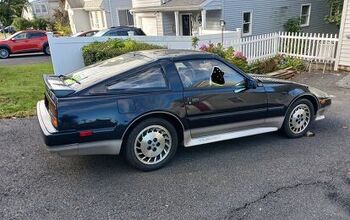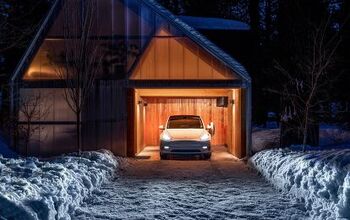Junkyard Find: 1991 Toyota Camry DX With V6 Engine and Five-Speed Manual Transmission

When I poke through automotive graveyards in search of the rare and the interesting, I always take a look at late-1980s/early-1990s Toyota Camrys for the very rare All-Trac all-wheel-drive versions and extremely rare manual-transmission versions.
So rare that its existence in the wild is merely theoretical, however, is the V6-powered manual-transmission Camry… and I just found one in Denver. Let’s take a look!
You’ll see plenty of first-generation North American Camrys with manual transmissions, of course, but the 1988-1991 versions were about 99 (and many more nines) percent slushboxes. I’ve seen a handful of four-cylinder manuals from this generation, but today’s Junkyard Find is the first five-speed/V6 V20 Camry I have seen. (Outside of a 24 Hours of LeMons race, that is.)
Just over 155,000 miles on the clock, and there’s a timing belt replacement sticker in the engine compartment from a year ago, at 148,824 miles.
The engine is sprayed orange, which means it’s bad. This was something that was done during the Cash For Clunkers era. Colorado doesn’t have an emissions buyback program that I’m aware of, so I’m not sure how this yard specifies engines that should not be purchased.
The interior looks just about new. Note the misery-inducing automatic seat belts, required by the federal government in cars that had no driver’s-side airbags in 1991.
I have a soft spot for this generation of Camry, all thanks to some family history. My parents, patriotic Midwesterners who insisted on buying Detroit cars whenever possible (with a notable exception), got burned so badly by a Chevrolet Celebrity Eurosport in the late 1980s that they vowed to avoid American cars forever. They bought a new 1990 Camry.
This car went 250,000 miles (my dad was a salesman whose territory encompassed California north of Fresno and all of Nevada) and had just one problem beyond normal maintenance in all that time: the reverse-lockout button on the automatic gearshift had the return spring fail at 200,000 miles. It was handed down to my sister, who drove it another 50,000 miles before selling it and getting a high-maintenance Volvo wagon. I borrowed it in the mid-2000s for a firearms-in-the-desert expedition; this 35mm slide is the only photograph I can find of this amazingly reliable machine.
These cars were not fun, not even with the 153-horse V6 and five-speed. You don’t buy a Camry for fun. You buy a Camry for the same reason that smart people bought Mercedes-Benz sedans in the 1960s: because they will not break.
Why did this one end up in a place like this, before it made it to 200,000 miles? We will never know.

Murilee Martin is the pen name of Phil Greden, a writer who has lived in Minnesota, California, Georgia and (now) Colorado. He has toiled at copywriting, technical writing, junkmail writing, fiction writing and now automotive writing. He has owned many terrible vehicles and some good ones. He spends a great deal of time in self-service junkyards. These days, he writes for publications including Autoweek, Autoblog, Hagerty, The Truth About Cars and Capital One.
More by Murilee Martin
Latest Car Reviews
Read moreLatest Product Reviews
Read moreRecent Comments
- Theflyersfan After looking it over, Honda, I want royalties for this one: The Honda Yawn.
- V8fairy Not scared, but I would be reluctant to put my trust in it. The technology is just not quite there yet
- V8fairy Headlights that switch on/off with the ignition - similar to the requirement that Sweden has- lights must run any time the car is on.Definitely knobs and buttons, touchscreens should only be for navigation and phone mirroring and configuration of non essential items like stereo balance/ fade etc>Bagpipes for following too close.A following distance warning system - I'd be happy to see made mandatory. And bagpipes would be a good choice for this, so hard to put up with!ABS probably should be a mandatory requirementI personally would like to have blind spot monitoring, although should absolutely NOT be mandatory. Is there a blind spot monitoring kit that could be rerofitted to a 1980 Cadillac?
- IBx1 A manual transmission
- Bd2 All these inane posts (often referencing Hyundai, Kia) the past week are by "Anal" who has been using my handle, so just ignore them...

















































Comments
Join the conversation
These 2nd generation Camry's are what sold people on Camry's. I'm sure many moved up from Corolla and Corona's. I wonder if the V6 5-speed drivetrain from this era Camry would fit in a 1st or 2nd generation MR2. I know those have a lot of Corolla components but a V6 would be quite the hoon.
Hey guys! I actually own a 1991 Toyota Camry v6 with a manual transmission. I came here looking for some info on what I’ve got in terms of how special it is. I can’t get any production numbers from Toyota. Is finding out how rare it is a lost cause or any of you know someone? hahah! Info about my car: My car was flat towed behind an RV almost it’s entire life. Spent very little time driving. I’m the second owner. The guy who sold it to me unfortunately had a son terminally ill and wanted to get rid of rv and car to clear out because he was moving across country to be with his son. It’s got 194 thousand miles on it (mechanical speedo, so counting miles while flat towed). Nearly rust free. Have a couple spots that are fixable. Needs a good paint job because it lived under the sun. I plan on having professionally redone in next year or so. Top of dash is ruined but I have no plans to fix that sun damage. Already invested a lot into getting it running. And spent months finding what Toyota told me was the last oem clutch in the country (cross my fingers that the flywheel holds for years to come) It’s a beyond surprising blast to drive. A near 7k redline. Pretty quick. Very surprisingly stable. Good twisty turny road car. And stick shift. Someone help me find some info on it please! It’s impossible to find any information about this car. Because it seems like it doesn’t exist yet I’ve got one in my driveway.